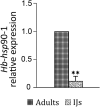Molecular Characterization and Functional Analysis of the Hb-hsp 90-1 Gene in Relation to Temperature Changes in Heterorhabditis bacteriophora
- PMID: 33732162
- PMCID: PMC7959791
- DOI: 10.3389/fphys.2021.615653
Molecular Characterization and Functional Analysis of the Hb-hsp 90-1 Gene in Relation to Temperature Changes in Heterorhabditis bacteriophora
Abstract
Understanding how entomopathogenic nematodes respond to temperature changes and have adapted to the local environment is crucial to improve their potential as biocontrol agents. In order to improve understanding of Heterorhabditis bacteriophora's potential adaptability to future climate changes, full-length cDNA and the corresponding gene of heat shock protein 90 (Hsp90) were isolated and fully characterized. The reproductive potential of the Apulian strain of H. bacteriophora increased when the temperature rose from 23 to 30°C, but no reproduction was found at 12°C. Expression analyses revealed that Hb-hsp90-1 was differentially expressed in Infective Juveniles (IJs) and adults (hermaphrodites, females and males). Up-regulation of Hb-hsp90-1 was higher during the recovery process in Galleria mellonella larvae than adults, thus confirming the protective role of Hb-hsp90-1 in coping with the host environment. Silencing of Hb-hsp90-1 resulted in a significant reduction (76%) in the expression level. Silenced IJs took longer than untreated nematodes to infect G. mellonella, showing that Hb-hsp90-1 could be also involved in chemosensation. Furthermore, the number of adults and IJs recovered from G. mellonella infected with silenced nematodes and incubated at 30°C was higher than that obtained from G. mellonella infected with untreated nematodes. These data confirm the crucial role of Hb-hsp90-1 allowing acclimation to increased temperatures and modulation of the recovery process.
Keywords: EPN; acclimation; gene duplication; heat shock protein; silencing; thermotolerance.
Copyright © 2021 Fanelli, Troccoli, Tarasco and De Luca.
Conflict of interest statement
The authors declare that the research was conducted in the absence of any commercial or financial relationships that could be construed as a potential conflict of interest.
Figures











Similar articles
-
In vivo production of entomopathogenic nematodes using Galleria mellonella: costs and effect of diets on nematode pathogenicity.J Nematol. 2019;51:1-15. doi: 10.21307/jofnem-2019-066. J Nematol. 2019. PMID: 31814368 Free PMC article.
-
Effects of storage temperature on survival and infectivity of three indigenous entomopathogenic nematodes strains (Steinernematidae and Heterorhabditidae) from Meghalaya, India.J Parasit Dis. 2016 Dec;40(4):1150-1154. doi: 10.1007/s12639-014-0639-8. Epub 2015 Jan 20. J Parasit Dis. 2016. PMID: 27876904 Free PMC article.
-
Rapid age-related changes in infection behavior of entomopathogenic nematodes.J Parasitol. 2004 Dec;90(6):1229-34. doi: 10.1645/GE-3315. J Parasitol. 2004. PMID: 15715211
-
First record of entomopathogenic nematodes from Yucatán State, México and their infectivity capacity against Aedes aegypti.PeerJ. 2021 Jul 2;9:e11633. doi: 10.7717/peerj.11633. eCollection 2021. PeerJ. 2021. PMID: 34249499 Free PMC article.
-
Volatile organic compounds of Metarhizium brunneum influence the efficacy of entomopathogenic nematodes in insect control.Biol Control. 2021 Apr;155:104527. doi: 10.1016/j.biocontrol.2020.104527. Biol Control. 2021. PMID: 33814871 Free PMC article.
Cited by
-
Novel Nematode-Killing Protein-1 (Nkp-1) from a Marine Epiphytic Bacterium Pseudoalteromonas tunicata.Biomedicines. 2021 Oct 30;9(11):1586. doi: 10.3390/biomedicines9111586. Biomedicines. 2021. PMID: 34829814 Free PMC article.
-
Heat Shock Proteins as Potential Indicators of Induced Stress in Nematodes.Methods Mol Biol. 2024;2756:343-350. doi: 10.1007/978-1-0716-3638-1_13. Methods Mol Biol. 2024. PMID: 38427304
-
Pratylenchus vovlasi sp. Nov. (Nematoda: Pratylenchidae) on Raspberries in North Italy with a Morphometrical and Molecular Characterization.Plants (Basel). 2021 May 26;10(6):1068. doi: 10.3390/plants10061068. Plants (Basel). 2021. PMID: 34073469 Free PMC article.
-
Temperature Effects on Expression Levels of hsp Genes in Eggs and Second-Stage Juveniles of Meloidogyne hapla Chitwood, 1949.Int J Mol Sci. 2024 Apr 29;25(9):4867. doi: 10.3390/ijms25094867. Int J Mol Sci. 2024. PMID: 38732085 Free PMC article.
-
Effect of Vicia sativa L. on Motility, Mortality and Expression Levels of hsp Genes in J2 Stage of Meloidogyne hapla.J Nematol. 2023 Apr 14;55(1):20230009. doi: 10.2478/jofnem-2023-0009. eCollection 2023 Feb. J Nematol. 2023. PMID: 37082220 Free PMC article.
References
LinkOut - more resources
Full Text Sources
Other Literature Sources

